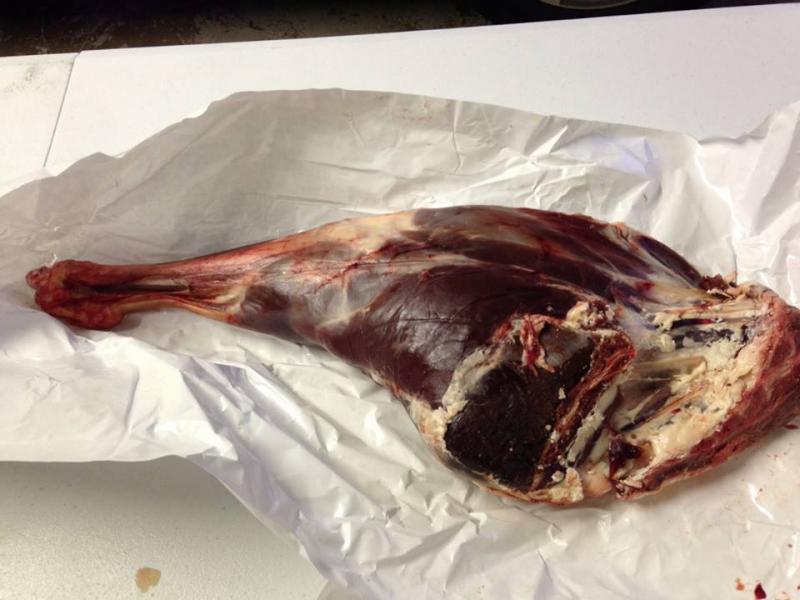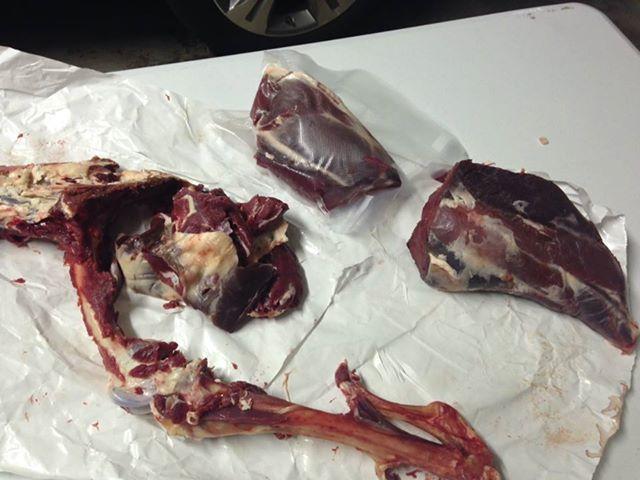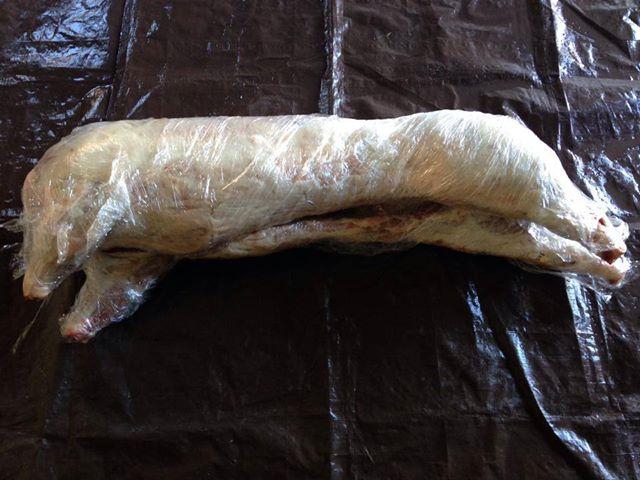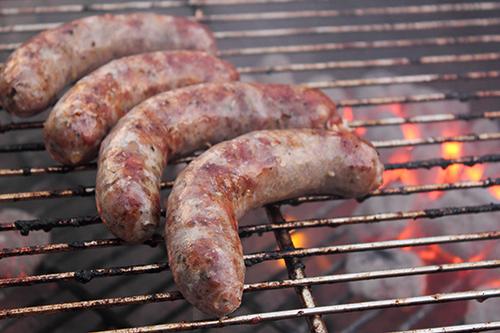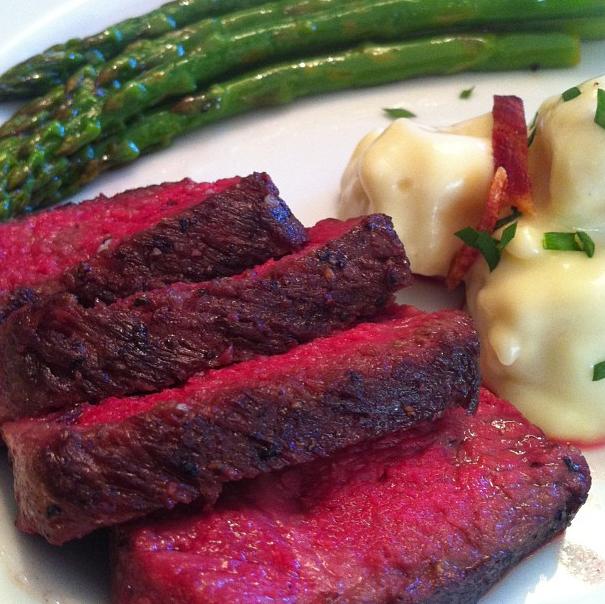-
Posts
275 -
Joined
-
Last visited
Content Type
Profiles
Forums
Store
Help Articles
Everything posted by Rico
-
I just bought the Fat Duck cookbook and The Perfect Meal based on this - has anyone else out there read any of these? Any of the others worth looking into, in your opinion?
-
I would avoid the ones that have curly noodles. I'm going to recommend googling Momofuku's ramen recipe, but with the caveat that I think you should buy the book. It's great, and most of the sites that give his recipe are simply ... well, plagiarizing his work. But off the soapbox, that was my first ramen that I made, and it turned out great. For the amount of time it takes, you want to take the time to do it right.
-
@avaserfi, do you recall under what conditions you aged the chops? I've got a Berkshire coming in this week, and I'd like to give one of the loins a similar treatment. (The other is turning into lonzino).
-
Thank you all for the responses. And I might add, to specify, everyone on eGullet is my culinary hero. It has large part responsible for my culinary education over the past 10 years. Blether, the freezer is a good idea; I know bread freezes well, but for some reason don't want to believe it - likely due to those times I've put a lof in the freezer only to rediscover it six months later heavily laden with freezer burn. Do you just put the bread in a ziploc and throw it in there, or do you have a specific way to freeze it? I usually count the eggs as 50/50 fat and water (so, for example, the portuguese-style bun has a hydration of 54 percent and a fat percentage of 36 percent). The yolk is somewhere around 60 percent fat, so I may be overaccounting for that aspect of it at the expense of hydration, but surely only by a couple percentage points, right? Andie, I use the milk powder in the Portuguese style bread, but I've never specified whole milk. The added fats surely have a beneficial effect. I'll try that immediately. CatPoet, your post is a revelatory one - I never realized the scalding of flour (what I refer to as tangzhong above) - was a common practice in Scandinavia until I read your post and researched 'scalding flour'. I thought it was a purely Asian approach. Something new every day, right? I just discovered the approach a few weeks ago and yes, it's amazing: the difference is significant, plus it offers an interesting way to incorporate flavor into the bread. Ultimately what I want is about the most un-'artisan' bread we can think of. I don't want that shatteringly brittle crust, or a crumb beautifully arrayed with an assortment of shapes; just a plain, supersoft, slightly chewy white roll. If I must use the freezer, that's fine, but if I can make it last for just a few days unchanged, that would be ideal.
-
Note: There is no doubt a conversation on eGullet somewhere that addresses the issue, but my searching skills, despite years on the site, still remain markedly flawed. That said, I have a question. The title of the post should read, rather, 'bread that lasts and is pillowy soft for days. I'm not scared of using those nebulous 'additives,' though I'd rather not. Here's the issue: I'd like to make buns like, say, In-n-Out or Chic Fil A. Buns that are inoffensive and squishy soft. I'd like to understand how they get the texture and - also important - how they get them to last that way. For my purposes I would go beyond those basic buns, but I need a starting point. There are two methods I've used so far that have gotten me the best results - both high hydration and/or fat - but neither is close enough to what I'm looking for. Not sure of the standard baking percentages, but I always just ratio based on the largest quantity of flour type. Tangzhong: AP Flour: 100% Potato Flour: 12% Pre-saturated Slurry, 5:1 water to flour: 7.5% Water: 30% Milk: 30% Butter: 24% Eggs: 15% Salt: 2.5% Sugar: 14% Yeast around 1 percent. Crumb is right with a featheriness about it. Density seems right, but I want a softer give when I bite in. And then the other is pretty much a variation of the portuguese sweet roll in the KA cookbook. Texture is right, but I can't get it to last. Again, not scared of adding additives, but don't want to jump to it if there's a more traditional way. Help from my eGullet culinary heroes appreciated.
-
How do you find the farmed duck varies from the wild? Right there with you, Shelby, though I'll occasionally buy the farmed stuff if I want the fat or am dry curing them. Seems like down here they've all already used up their fat stores by the time they arrive. I'm lucky to get any at all on them. They do make great pastrami. Each has its place; they are almost completely different different ingredients. Like beef to venison. As for SV prep of the wild ones, gfweb, I've done it a few times with a decent amount of success. My favorite prep is to take them whole (each breast is maybe two ounces), dip in a little batter and throw them in the frying pan for a couple minutes.
-
And a victory, for now - appears they are backing off. http://www.forbes.com/sites/gregorymcneal/2014/06/10/fda-backs-down-in-fight-over-aged-cheese/
-
There is a blizzard, off the menu now but present there 25 years ago when I had my first Blizzard, called Chocolate Covered Cherry. It is their cherry blizzard mixed with the dipped cone chocolate. It can still be ordered. So much as a DQ Dinky of it (ht Toliver) will form an addiction that lasts at least a quarter of a century.
-
That is some fantastic looking pork! The only time I've seen them that fatty is Mangalitsa - is that what you got? If so, and at two bones a pound, I'd pay a lot of money just to get the name and number of that farmer of yours ... As for the lardo, our eG friend jmolinari has a recipe for lardo that I've tried and had success with, as well. It's a 3-month brine. http://curedmeats.blogspot.com/2010/04/lardo-darnad.html
-
To understand the principles of pastry, I think, is my goal for 2014. Chocolate tempering and shaping, laminated doughs, yeasted bread; all of it. I'd like to look at anything the best pastry chefs make and say - if not "I can make that" - at least "I understand how he or she made that."
-
Flatten a tasteless hot dog into the shape of ... well, whatever the shape of that thing is, and that seems like a good textural reference - emulsified meat. Thank you Jaymes for sparing me the surprise of the texture. Overall, though, I can see why it's popular. Those are bold flavors for a place like McDonalds, and for someone who's maybe just accustomed to big macs and quarter pounders, it may very well be a daring culinary adventure. Actually, it was a daring culinary adventure for me, too. Just not one I'll be repeating.
-
Here's the problem. Even though I expect it to be a dreadful experience, enough of the folks on here have pulled the trigger to make me want to be part of the order. By not having been hazed by this sandwich, I feel I am unable to relate wholly to those who have undergone the experience. I apparently lack the self confidence to stand alone in my McRib ignorance. The valleys make the peaks more gratifying anyway, right? I'm on my way.
-
To be fair, I live in the suburbs, drive a pickup and eat animals. Some of which I have acquired after hunting them. Whole Foods also attracts me. Though if someone were to give me a BMW, I wouldn't fight it. And I think through various experiences recalled in the thread, we can probably conclude that the thesis (and correct me if I'm wrong, but I'll paraphrase it) of "Shopping at Whole Foods doesn't necessarily mean you will be spending much more money than at a regular grocery store" is true in many cases. This is based on anecdotal evidence from above. The thesis that was never presented, but seems to have been inferred is, "Shopping at Whole Foods equals thrifty spending." I do not believe that anyone made the assertion, though that seems to be the one that is being argued. I would not argue for the second point.
-
Prawncrackers, this might answer your question, but I'm not exactly how he's cutting it. Arbitrarily? Or are there specific muscles/sizes/shapes to follow? Shelby - that's a great idea! But even 80 percent with this venison might be too much. I'm thinking 20 will be ample. And Martin, it's going to be three months before I can even pronounce rådjursköttbullar. Doesn't mean I can't make them, though. Got a recipe, by any chance?
-
I have started doing a moderate amount of drinking at the beer and wine bar inside my new local Whole Foods, as well. That particular aspect is not just comparable, but notably less expensive than at a counterpart. No, it's not the dark bar atmosphere that I typically enjoy, but the bartenders are pleasant and knowledgable and the TVs work ... (Edited to specify beer and wine bar)
-
Thanks for the kind words, all. And dcarch, your premonition is likely correct Also, I'll be asking for the blood next time. Learned a lot about what to request and such this time around. Rotuts - it was the whole head, and I hardly even had to scrape meat off at the end; it just fell off. I did have to double-check for teeth, as a couple fell out during the cooking (the bone did get really, really soft). As luck would have it, a buddy of mine went hunting and took down a deer last weekend. He was generous enough to give me a hindquarter. I cut it into two fairly sizeable 'roasts' (no more than four pounds or so each) and had about another pound that will be destined for some sausage. It's a gamey one, to be sure, so I'll be mixing the venison in with pork for the sausages. 100 percent of this stuff in a sausage would be too much, even with really heavy seasoning.
-
So, as promised, the head cheese. I did it in a pressure cooker, seasoned only with salt and pepper (a healthy portion of both), and let it cook at about 11 psi for 90 minutes before turning off the heat. It took another hour for it to cool down to where I could open it. Again, I'll apologize for the lack of photos. This process can get your hands really, really fatty. And collagen-y. Before boiling I added some of the skin that the butcher missed. It was a fatty affair, as the end result ended up showing. The pressure cooker, though, performed amazingly - almost too much so. The entire skull was about to disintegrate by the time I pulled it out. A careful scan for teeth in the meat was necessary before stuffing. Another 20 minutes and the entire thing may just have been too soft and squishy. That to say, the stock was super gelatinous. (A quick note: While stuffing head cheese, I'll bet the professionals never have to run though the house calling their wives yelling, "I know I promised you wouldn't have to see it, but I need you to cut a piece of string and tie this for me!" In a tone well beyond desperation, all while trying to close the garage door with your foot so your dog doesn't go counter surf on the table where you've got the pig's head. You know why that never happens to professionals? Because they're professionals. And they've got two thumbs - that's the fourth thing on my 32-year-and-running list that outlines what sucks about having only one hand:1. Can't cross monkey bars2. Can't juggle3. Can't ever give two thumbs up, so people always think you're only moderately excited about something.4. Can't seal the top of the casing for head cheese by yourself.) Anyway, I used 90 mm collagen casings, since that's what I had on hand. Kept it in the fridge overnight and ended up with this: I like it. The texture is a little overcooked, a little closer to pate than head cheese (you can feel a little resistance to the meaty bit, but I'd like a touch more), but considering it's my first go-round with head cheese, I'm pretty pleased. I might cold smoke it this weekend, just for four or five hours. Then crusty bread.
-
Yes! A sawsall! I have one in the garage. It is sitting there unaware that its life and purpose are about to completely change. Martin - What are some of the most abused cuts in the American style that would be better used into cuts via seam? Like, I would imagine the tenderloin is the tenderloin, the loin the loin, no matter what system. Are the differences mainly in the shoulder/ham areas?
-
*Kidneys, not livers. I'm dumb. Shalmanese - That was one of my biggest takeaways from the process. The easiest cuts to butcher were, naturally I suppose, the ones that require less fighting with the meat and more working with the natural lines where the muscles and muscle groups separate. I tried to keep the cuts as identifiable in American terms as I could this time around just because it's what I'm familiar with and have a better idea if I'm doing it properly, but in the future will definitely explore how other countries and cultures break them down. Rotuts - Love both those books, and yes, the more conspiratorial side of me suspects their purposes in removing them were nefarious - to use them in some wonderful way for themselves (eyes shifting suspiciously) ... Oliver - When you saw small parts, do you mean bits of scrap, or actual 'cuts' that were just to small to serve any practical purpose. And looking at the alternative of shaving or skinning the animal myself, yes, having them skin it is definitely preferable! Sometimes all I need is a little perspective ... Yeah, definitely worth it to have them halve the animal (or acquire a band saw). dcarch, to that point, would a table saw work in halving the carcass through the spine?
-
I've been threatening to do it for years, and finally pulled the trigger about a month ago and bought a whole Berkshire pig from a farm about an hour or so from where I live. They killed, cleaned and split it (and skinned it, a point I'll address further) and I went home with two halves and a head of a pig. I'm not sure how to explain my reasoning without sounding soapboxy, so I'll just say that this 124-pound beast was purchased at a price of $3.95/pound. That's $3.95/pound for the tenderloin and $3.95 for the butt, trotters and stock bones. All in all - given the manner in which this pig was raised - it's a huge savings. On a more personal level, it helps me appreciate what I'm eating. That its life ended solely to feed me, and that my phone call to the farm essentially sealed its fate. You bet I'm going to use and appreciate every bit of this beast. All that to say, I consider myself lucky to be able to do such a thing, and am now hooked on whole-animal butchery. If it's agreeable to y'all, I'd like to start a thread on what and how we're butchering our meats, the differences in different breeds/birds/animals/fish, etc, and how we're consuming them. We will be doing a lamb in a few months (after subsisting on pork for awhile) and I'll photodocument the process a little better. This was my first go (I split it with a friend who has a similar lack of experience), but the results ended up nicely considering our beginner status (thanks to a few youtube videos). I'll be making head cheese and starting a 'proscuitto' with the ham (going to jmolinari's site in the process) in the following days and documenting them, if y'all are amenable to the idea. The farm took off and kept the trotters, which is irritating, but kept the livers in. Is there such thing as a smoked pork liver rillette? Can there be?
-
Ugh. I feel as if doing such a thing would induce guilt rather than absolve it ...
-
Got a big kick out of this one ...
-
Agree with everything said so far by dcarch and pastameshugana - figured I'd make a contribution for discussion, though I would probably put my photography somewhere closer to the 'documentation' side of things, if only because that's all I really know. I really, honestly, don't know whether there are aspects that would be considered 'artistic' rather than purely photographic documentation.
-
I certainly will - I'm in pretty good with these fellas, too, so they'll likely take the time to explain exactly how and from where on the animal they're cutting it; they're one of the few whole-animal butcher shops in the area, and are always eager to talk shop. Scuba - Many thanks! Though I must admit it likely has more to do with the quality of meat than anything I might have done to it. Basically, all I had to do was make sure I didn't screw up the searing part!
-
Had some friends over the other night, so went with a play on steak and potatoes. There's a butcher up North of me that sells chuck in rectangular cuts (maybe 2"x2"x8") so I bought a couple, seasoned them, jaccarded them and put them in the SVS at 132 for seven or eight hours. Seared them in beef fat after. Had fun with the 'potatoes' aspect; made gnocchi and a cheese sauce with aged cheddar. Some home-cured bacon and garden chives gave it a mac-and-cheese-meets-baked-potato feel.




